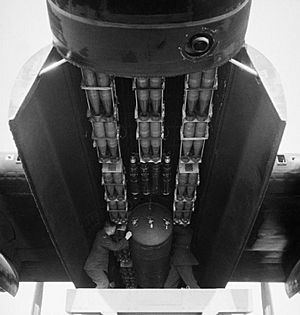Area bombing directive facts for kids

The Area Bombing Directive was a special order given by the British government during World War II. It came from the Air Ministry to the Royal Air Force (RAF). This order told RAF Bomber Command to attack German cities. The main goal was to damage Germany's factories and lower the spirits of the German people. This was done by bombing cities and their residents.
Why the Directive Was Made
The Area Bombing Directive (officially called General Directive No.5) was an update to an earlier order. It was issued on February 14, 1942. The first order, from February 5, 1942, told RAF Bomber Command that bombing factories in occupied France was their top job. But the new directive changed this. It made targets in Germany the main focus for the RAF.
The directive from February 14 listed important industrial areas in Germany. These areas were within 350 miles of RAF Mildenhall. This distance was about how far the GEE radio navigation system could reach. The order specifically mentioned the Ruhr region. It said that Essen, a city in the Ruhr, would be the first target. The first attack on Essen under this new order happened on the night of March 8/9.
The main aim of the directive was to "focus attacks on the morale of the enemy civil population and in particular the industrial workers." This meant trying to make German citizens and factory workers feel scared and lose hope. For Berlin, the goal was to keep people afraid of raids. This would make them use up resources on Air Raid Precautions (ARP) measures.
The directive also listed other German cities to be bombed with high explosives. These included Duisburg, Düsseldorf, and Cologne. Billancourt in occupied France, which was the main target in the earlier directive, became a secondary target. The RAF was also told to help with other military operations. For example, they could bomb naval ships if good chances to hit main targets were not missed.
The directive also said, "You are accordingly authorised to employ your forces without restriction." This meant Bomber Command could use all its planes. An earlier order from November 1941 had told them to save their forces. This was because they had lost many planes to German night fighters.
The day after the directive was issued, on February 15, 1942, Charles Portal asked for more details. He was the head of the Air Staff. He wanted to make sure that the bombing targets were the built-up areas of cities. He did not want them to be just specific factories or dockyards.
The first big city attacked in this new campaign was Essen. This happened on the night of March 8/9, 1942. After that, Essen and other large cities in the Ruhr were bombed repeatedly with incendiary (fire-starting) bombs. Then, when possible, fourteen other industrial cities across Germany were attacked.
Changes to the Directive
Between March 21 and September 3, 1942, the directive was changed eight more times. Here are some of the key changes:
- March 21: Focus on the Ruhr using many incendiary attacks. This was partly an experiment to see how effective different fire bombs were.
- April 16: Support operations by the Special Operations Executive (SOE).
- April 18: Daylight bombing of the Le Creusot Works in France.
- April 18: Bomb the Pilsen (Skoda) Works on the night of April 23/24. This was to help sabotage German supply lines to the Russian Front. It also aimed to boost Czech morale.
- May 5: Change secondary targets to Bremen, Kassel, Frankfurt, and Stuttgart. The goal was to reduce Germany's aircraft production, especially fighter planes. This would help Russia and planned combined operations.
- May 25: Added industrial plants used by Germans in all occupied countries as targets. Before, it only covered plants in France.
- June 16: New French targets were added. But these were only to be bombed by experienced crews. Also, the weather had to be good enough so that bombs would not accidentally hit nearby buildings for political reasons.
- September 3: The synthetic oil plant at Pölitz was added. The British thought it was the biggest in the world. They believed it supplied much of Germany's fuel for their war efforts on the Eastern Front.
Other orders also changed how the RAF operated while this directive was active. For example, on July 30, 1942, an order gave priority to "Transportation and Transformer Stations." On September 4, another order said that incendiary bombs should be dropped during harvest season. This was to cover sabotage operations.
On January 14, 1943, a new order gave priority to attacking U-boat pens. These were submarine bases in French cities like Lorient and St Nazaire.
Following the bombing of Genoa and Turin on October 23, 1942, and a speech by British Prime Minister Winston Churchill, a new directive was issued on January 17, 1943. This added industrial centers in Northern Italy to the bombing list. These included Milan, Turin, Genoa, and Spezia.
The Area Bombing Directive was later replaced by the Casablanca directive. This new directive was approved on January 21, 1943. It was issued by British and United States Army Air Force commanders on February 4, 1943.
See also
- Aerial bombardment and international law § International law up to 1945
- Dehousing paper – British Cabinet paper on the policy
- AF Bomber Command § Strategic bombing 1942–45)

